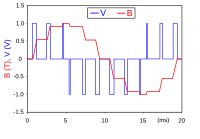
Photo from wikipedia
Background Due to the dynamics of developmental changes, the preschool age is of crucial importance for the later health and efficiency of the feet. The aim of this study was… Click to show full abstract
Background Due to the dynamics of developmental changes, the preschool age is of crucial importance for the later health and efficiency of the feet. The aim of this study was the analysis of the fitting of indoor footwear and its impact on the features of the foot structure in 6-year-old children. Methods The study group consisted of 100 children, including 50 girls and 50 boys at the age of 6 years. The applied device was the CQ-ST podoscope and the Clevermess. The data were analyzed based on Mann-Whitney U test, Chi-square test and regression analysis. Results About 60% of children wore correctly fitted shoes in terms of length and width. Multiple regression models with two variables explaining the variance of the Clarke’s angle were statistically significant for girls (right foot: p < 0.001 and left foot: p = 0.009), and boys (right foot: p < 0.001 and left foot: p < 0.001). The influence of predictive variables on the values of the heel angle (γ) was statistically significant for girls (right foot: p < 0.001 and left foot: p < 0.001) and boys (right foot p < 0.001 and left foot: p < 0.001). Conclusions Both in the case of girls and boys, the frequency of using too long and too wide shoes was higher in relation to the frequency of using too short and too narrow shoes. The length and width of the shoes affected the length and width of the footwear both in girls and boys. The longer and wider the shoes, the lower the height of the arch. Longer shoes are accompanied by a greater transverse arch, and wider ones with a lower transverse arch of the foot.
Journal Title: PeerJ
Year Published: 2022
Link to full text (if available)
Share on Social Media: Sign Up to like & get
recommendations!